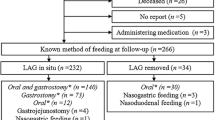Abstract
Purpose
Gastrostomy tube placement is one of the most commonly performed pediatric surgical procedures and discharge is possible as early as the first postoperative day with early initiation of feeds postoperatively. We examined a national database to determine hospital length of stay (LOS) after elective laparoscopic gastrostomy in children.
Methods
We queried the 2012–2013 National Surgical Quality Improvement Program Pediatric (NSQIP-P) database, including all patients who underwent elective laparoscopic gastrostomy tube placement for failure to thrive or feeding difficulties. Demographic data, admission status, disposition at discharge, surgical subspecialty data and hospital LOS were extracted.
Results
A total of 599 patients underwent gastrostomy tube placement for failure to thrive or feeding intolerance. The majority, 52%, was male and 69.3% were White. The median age was 2.2 years (IQR 0.9–6.3). Of the total, 28.7% were infants. The median total hospital LOS was 2 days (IQR 1–2), with only 39% discharged in a day or less.
Conclusion
Pediatric patients undergoing elective laparoscopic gastrostomy have a median hospital length of stay of 2 days, despite evidence that early feeding and discharge within 24 h is both feasible and safe. There is potential for the implementation of an enhanced recovery protocol as a quality metric for this procedure.

Similar content being viewed by others
References
Adamina M, Kehlet H, Tomlinson GA, Senagore AJ, Delaney CP (2011) Enhanced recovery pathways optimize health outcomes and resource utilization: a meta-analysis of randomized controlled trials in colorectal surgery. Surgery 149(6):830–840
Nicholson A, Lowe MC, Parker J, Lewis SR, Alderson P, Smith AF (2014) Systematic review and meta-analysis of enhanced recovery programmes in surgical patients. Br J Surg 101(3):172–188
Shinnick JK, Short HL, Heiss KF, Santore MT, Blakely ML, Raval MV (2016) Enhancing recovery in pediatric surgery: a review of the literature. J Surg Res 202(1):165–176
Behr CA, Hesketh AJ, Akerman M, Dolgin SE, Cowles RA (2015) Recent trends in the operative experience of junior pediatric surgical attendings: a study of APSA applicant case logs. J Pediatr Surg 50(1):186–190
Sunstrom R, Hamilton N, Fialkowski E et al (2016) Minimizing variance in pediatric gastrostomy: does standardized perioperative feeding plan decrease cost and improve outcomes? Am J Surg 211(5):948–953
Pearsall EA, Meghji Z, Pitzul KB et al (2015) A qualitative study to understand the barriers and enablers in implementing an enhanced recovery after surgery program. Ann Surg 261(1):92–96
Murthy K, Dykes FD, Padula MA et al (2014) The Children’s Hospitals Neonatal Database: an overview of patient complexity, outcomes and variation in care. J Perinatol 34(8):582–586
Werlin S (1994) Early feeding after percutaneous endoscopic gastrostomy is safe in children. Gastointest Endosc 40(6):692–693
Franken J, Mauritz FA, Suksamanapun N, Hulsker CC, van der Zee DC, van Herwaarden-Lindeboom MY (2015) Efficacy and adverse events of laparoscopic gastrostomy placement in children: results of a large cohort study. Surg Endosc 29(6):1545–1552
Islek A, Sayar E, Yilmaz A, Artan R (2013) Percutaneous endoscopic gastrostomy in children: is early feeding safe? J Pediatr Gastroenterol Nutr 57(5):659–662
Sabir SH, Armstrong R, Elting LS, Wallace MJ, Gupta S, Tam AL (2014) Early initiation of enteral feeding in cancer patients after outpatient percutaneous fluoroscopy-guided gastrostomy catheter placement. J Vasc Intervent Radiol (JVIR) 25(4):618–622
Surgeons ACo. https://www.facs.org/quality-programs/childrens-surgery/pediatric/program-specifics/quality-support-tools/puf. Accessed 15 Dec 2018
Wragg RC, Salminen H, Pachl M et al (2012) Gastrostomy insertion in the 21st century: PEG or laparoscopic? Report from a large single-centre series. Pediatr Surg Int 28(5):443–448
Angsten G, Danielson J, Kassa AM, Lilja HE (2015) Outcome of laparoscopic versus open gastrostomy in children. Pediatr Surg Int 31(11):1067–1072
Vasseur Maurer S, Reinberg O (2015) Laparoscopic technique to perform a true Stamm gastrostomy in children. J Pediatr Surg 50(10):1797–1800
Jones VS, La Hei ER, Shun A (2007) Laparoscopic gastrostomy: the preferred method of gastrostomy in children. Pediatr Surg Int 23(11):1085–1089
Kehlet H, Wilmore DW (2008) Evidence-based surgical care and the evolution of fast-track surgery. Ann Surg 248(2):189–198
Lassen K, Soop M, Nygren J et al (2009) Consensus review of optimal perioperative care in colorectal surgery: Enhanced Recovery After Surgery (ERAS) Group recommendations. Arch Surg 144(10):961–969
Zhuang CL, Ye XZ, Zhang XD, Chen BC, Yu Z (2013) Enhanced recovery after surgery programs versus traditional care for colorectal surgery: a meta-analysis of randomized controlled trials. Dis Colon Rectum 56(5):667–678
Fox D, Campagna EJ, Friedlander J, Partrick DA, Rees DI, Kempe A (2014) National trends and outcomes of pediatric gastrostomy tube placement. J Pediatr Gastroenterol Nutr 59(5):582–588
Thatch KA, Yoo EY, Arthur LG 3rd (2010) A comparison of laparoscopic and open Nissen fundoplication and gastrostomy placement in the neonatal intensive care unit population. J Pediatr Surg 45(2):346–349
Hendrickson RJ, Poola AS, Sujka JA et al (2018) Feeding advancement and simultaneous transition to discharge (FASTDischarge) after laparoscopic gastrostomy. J Pediatr Surg 53(11):2326–2330
Best C, Hitchings H (2010) Day case gastrostomy placement for patients in the community. Br J Commun Nurs 15(6):272–278
Funding
This research did not receive any specific grant from funding agencies in the public, commercial or not-for-profit sectors.
Author information
Authors and Affiliations
Contributions
KW assisted with data analysis and was the primary author of the manuscript. LB assisted with writing of the manuscript. FA and RJH provided final editing of the manuscript. TAO conceptualized the project, performed data analysis and supervised the preparation of the manuscript.
Corresponding author
Ethics declarations
Conflict of interest
The authors report no proprietary or commercial interest in any product mentioned or concept discussed in this article.
Additional information
Publisher’s Note
Springer Nature remains neutral with regard to jurisdictional claims in published maps and institutional affiliations.
Rights and permissions
About this article
Cite this article
Williams, K., Baumann, L., Abdullah, F. et al. Elective laparoscopic gastrostomy in children: potential for an enhanced recovery protocol. Pediatr Surg Int 35, 643–647 (2019). https://doi.org/10.1007/s00383-019-04472-7
Accepted:
Published:
Issue Date:
DOI: https://doi.org/10.1007/s00383-019-04472-7




